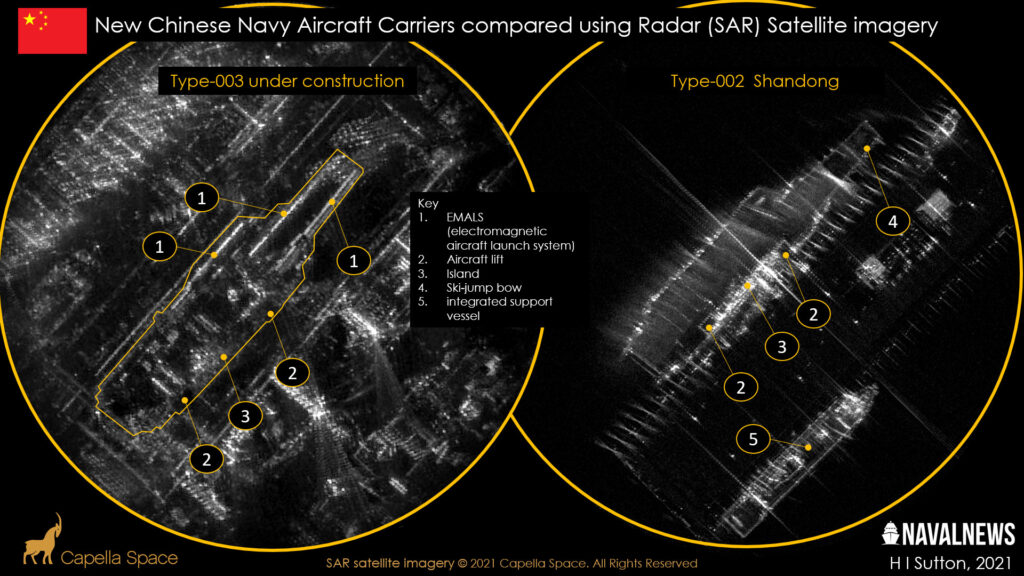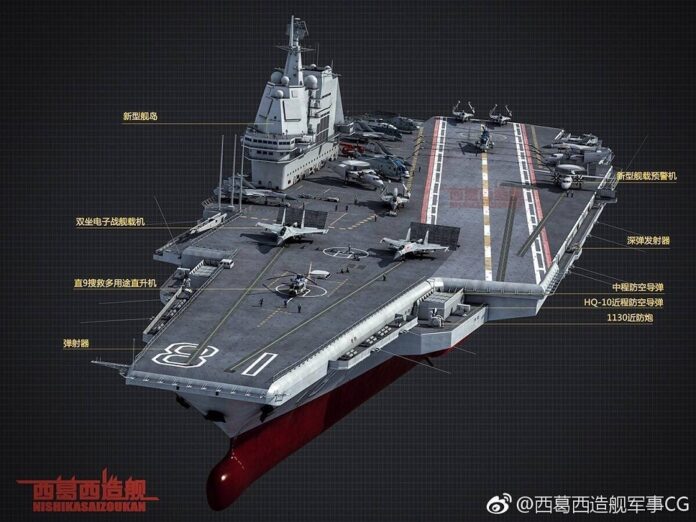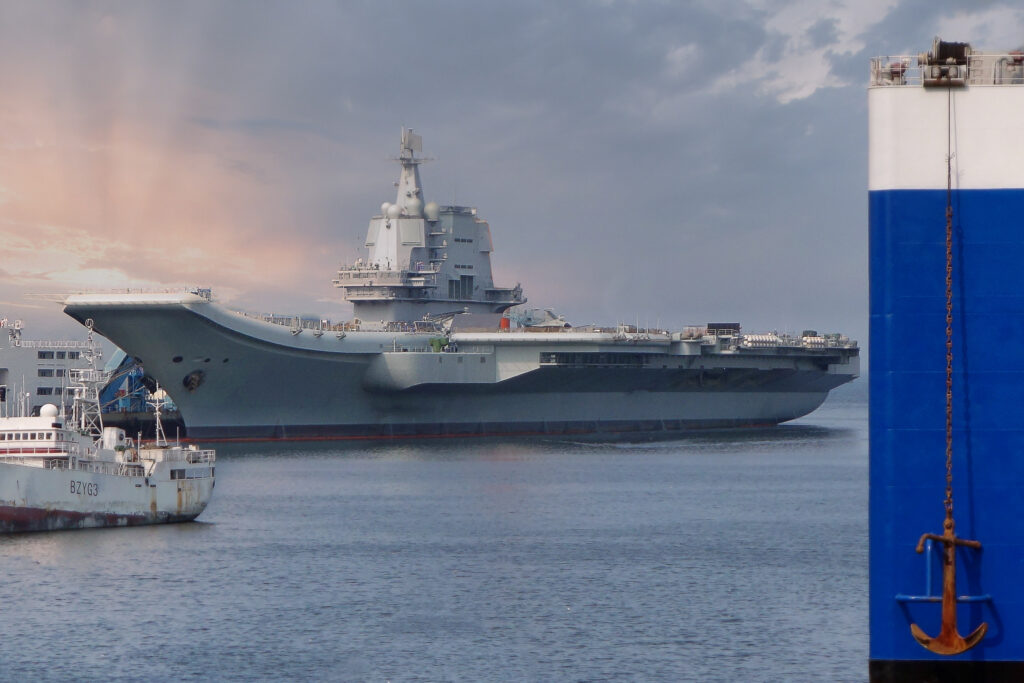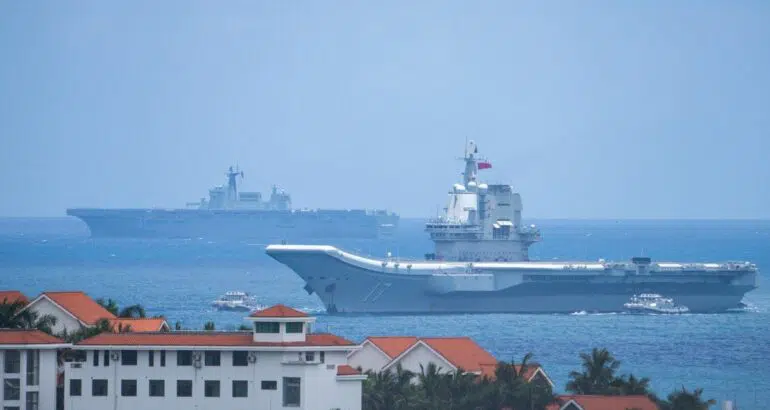Marinha da República Popular da China (PLAN)
Moderador: Conselho de Moderação
- P44
- Sênior

- Mensagens: 55877
- Registrado em: Ter Dez 07, 2004 6:34 am
- Localização: O raio que vos parta
- Agradeceu: 2944 vezes
- Agradeceram: 2630 vezes
Re: Marinha da República Popular da China (PLAN)
https://www.reuters.com/world/asia-paci ... 021-10-19/
China, Russia navy ships jointly sail through Japan strait
China, Russia navy ships jointly sail through Japan strait
*Turn on the news and eat their lies*
- FCarvalho
- Sênior

- Mensagens: 39606
- Registrado em: Sex Mai 02, 2003 6:55 pm
- Localização: Manaus
- Agradeceu: 6155 vezes
- Agradeceram: 3469 vezes
Re: Marinha da República Popular da China (PLAN)
Tá ficando cada vez mais legal essa nova novela The Pacific. Fortes emoções nas cenas dos próximos capítulos.
Carpe Diem
- P44
- Sênior

- Mensagens: 55877
- Registrado em: Ter Dez 07, 2004 6:34 am
- Localização: O raio que vos parta
- Agradeceu: 2944 vezes
- Agradeceram: 2630 vezes
Re: Marinha da República Popular da China (PLAN)
China commissions its largest ocean-going patrol ship
INDUSTRY NEWS
October 26, 2021, by Fatima Bahtić
China has commissioned its largest maritime patrol vessel in Guangzhou City, Guangdong Province to enhance maritime security operations in the deep sea.
The vessel Hai Xu 09 measures 165 meters in length, with a width of 20.6 meters and 9.5 meters depth. It has a maximum speed of over 25 knots. According to the officials, the vessel has a full load displacement of 10,700 tons, making it the country’s first official vessel with a displacement of more than 10,000 tons.
The unit is equipped with a helicopter landing pad and a data center with satellite communication systems, including China’s Beidou Navigation Satellite System. Furthermore, it was designed to sail up to 90 days between being supplied with fuel and food.
Its construction started in May 2019 at the China State Shipbuilding yard in Guangzhou while the launching ceremony was held in September 2020.
Local media reported that “it will serve as a mobile law enforcement platform for maritime patrols as well as emergency coordination and command and command of pollution prevention.”
The patrol vessel will be operated under China Maritime Safety Administration’s Guangzhou unit.
https://www.navaltoday.com/2021/10/26/c ... trol-ship/
https://www.maritime-executive.com/arti ... rol-vessel


INDUSTRY NEWS
October 26, 2021, by Fatima Bahtić
China has commissioned its largest maritime patrol vessel in Guangzhou City, Guangdong Province to enhance maritime security operations in the deep sea.
The vessel Hai Xu 09 measures 165 meters in length, with a width of 20.6 meters and 9.5 meters depth. It has a maximum speed of over 25 knots. According to the officials, the vessel has a full load displacement of 10,700 tons, making it the country’s first official vessel with a displacement of more than 10,000 tons.
The unit is equipped with a helicopter landing pad and a data center with satellite communication systems, including China’s Beidou Navigation Satellite System. Furthermore, it was designed to sail up to 90 days between being supplied with fuel and food.
Its construction started in May 2019 at the China State Shipbuilding yard in Guangzhou while the launching ceremony was held in September 2020.
Local media reported that “it will serve as a mobile law enforcement platform for maritime patrols as well as emergency coordination and command and command of pollution prevention.”
The patrol vessel will be operated under China Maritime Safety Administration’s Guangzhou unit.
https://www.navaltoday.com/2021/10/26/c ... trol-ship/
https://www.maritime-executive.com/arti ... rol-vessel


*Turn on the news and eat their lies*
- P44
- Sênior

- Mensagens: 55877
- Registrado em: Ter Dez 07, 2004 6:34 am
- Localização: O raio que vos parta
- Agradeceu: 2944 vezes
- Agradeceram: 2630 vezes
Re: Marinha da República Popular da China (PLAN)

China’s Massive New Aircraft Carrier Is As Big As It Can Be
Aircraft carriers are at the vanguard of China's incredible naval expansion A new, larger super-carrier is being built near Shanghai. Analysis of radar satellite imagery shows that it is as large as China's new bases allow.
Home»News»China’s Massive New Aircraft Carrier Is As Big As It Can Be
SH Defence The Cube
Chinese aircraft carrier in dry dock satellite image
Click to Enlarge. The new dry dock on Hainan in the South China Sea is only just large enough for the Type-003 aircraft carrier. This suggests that future carriers will be the same size.
China’s Massive New Aircraft Carrier Is As Big As It Can Be
Aircraft carriers are at the vanguard of China's incredible naval expansion A new, larger super-carrier is being built near Shanghai. Analysis of radar satellite imagery shows that it is as large as China's new bases allow.
H I Sutton 27 Oct 2021
The growth of the Chinese Navy has been incredible. The PLAN (People’s Liberation Army Navy) is barely recognizable from itself twenty years ago. Among the most important developments have been aircraft carriers.
Defense analysts have been trawling open source intelligence (OSINT) to keep up with developments. But like much of China, the shipyard building the latest carrier is protected from traditional satellite observation by impenetrable cloud. A new commercial satellite has provided Naval News with a way to see through this cloud.
Seeing In The Dark Or Through Cloud
Using SAR (Synthetic Aperture Radar) satellites owned by Capella Space we have checked progress on the carrier. This radar imagery can see through the clouds, and at night.
Starting from 10 years ago with imported Russian technology, the latest design is starting to match the U.S. Navy’s super carriers. The PLAN now has two of the Russian-based carriers in service. And the third, the Type-003, is under construction near Shanghai. It is roughly comparable to the U.S. Navy’s Ford Class.
The SAR imagery picks out the three deck catapults, a major change from the Russian based carriers. Those rely on a ski-jump bow to launch aircraft. That works for the J-15 Flanker fighters but does not permit the KJ-600 AWE&C (airborne early warning and control) aircraft to operate. This new twin-prop plane closely resembles the E-2 Hawkeye and is seen as generally comparable to the latest models.
The new carrier as EMALS (electro-magnetic aircraft launch system), like catapults. This is the same technology tat the U.S. Navy is introducing with the Ford Class. It means that the KJ-600 can be operated. And it should improve the endurance of carrier borne fighters. In particular, a new stealthier carrier fighter is expected.

The Type-003 aircraft carrier is visible in this recent radar satellite (SAR) image from Capella Space.
Progress appears steady at the Shanghai yard. Another ship which was recently in the same dry dock, but nearer the river, has been moved. This was blocking the entrance of the dry dock so is a necessary step before the carrier is launched.
We do not believe that launch of the carrier is imminent however. This is because sections of a container ship have been moved into the dock behind the carrier. Two massive holes providing access to the inner workings. This is normal for aircraft carrier construction and the same can be seen on U.S. ships.
Analysis of the imagery also reveals insights on other warship programs. A number of the large hovercraft intended for amphibious ships are still present in the basin, along with other naval vessels.
Of particular interest however, the unique ‘Sailless’ submarine does not appear to be present. Analysts will be watching this submarine closely for signs of it entering operational service, or being moved to a research unit.
Size Matters
1,900 km (1,200 miles) further south, at Sanya on Hainan, work is continuing on a gigantic dry dock for the carriers. The facility is strategically located for access to the South China Sea. One carrier, the Type-002 Shandong, is already based there, together with most of China’s nuclear submarine fleet.
A large cofferdam was built in 2016-17 to keep the sea out while construction took place. The docks are now clearly visible in the SAR imagery. Measurements confirm that the new Type-003 aircraft carrier will be able to fit it. However it’s tight beam suggests that China does not have plans for substantially larger carriers.

The Type-003 carrier (left) is wider and loner tan the first two carriers, such as the Type-002 (left). Catapults replace the ski-jump allowing more types of aircraft to be operated.
Importantly, the largest new dock is only about 80 meters (268 feet) wide, which is the same as the docket where the Type-003 is being built. The Type-003 itself is also approximately 80m wide (our earlier estimates were slightly narrow as it turned out). This suggests that a) the Type-003 will fit inside the new dock, b) any new carrier cannot be any wider if it too is to fit.
Therefore it seems likely that the Type-003 represents the ‘full size’ Chinese aircraft carrier for the foreseeable future. The next ones may be longer, or greater displacement, but not wider. If they are, yet more infrastructure may need to be built.
The new aircraft carriers represent a significant increase in capabilities for the Chinese Navy. And also part of their emergence as a true blue-water force.
https://www.navalnews.com/naval-news/20 ... it-can-be/
*Turn on the news and eat their lies*
- P44
- Sênior

- Mensagens: 55877
- Registrado em: Ter Dez 07, 2004 6:34 am
- Localização: O raio que vos parta
- Agradeceu: 2944 vezes
- Agradeceram: 2630 vezes
- FCarvalho
- Sênior

- Mensagens: 39606
- Registrado em: Sex Mai 02, 2003 6:55 pm
- Localização: Manaus
- Agradeceu: 6155 vezes
- Agradeceram: 3469 vezes
Re: Marinha da República Popular da China (PLAN)
Creio que não restam dúvidas de que o J-35(J-31) é realmente um projeto voltado para a aviação embarcada da PLAN.
O aparecimento do J-20 bliplace também joga alguma luz sobre o futuro da composição das alas aéreas embarcadas dos novos Nae chineses.
Vai ser um jogo cada vez mais duro a vida da USN no pacífico.
O aparecimento do J-20 bliplace também joga alguma luz sobre o futuro da composição das alas aéreas embarcadas dos novos Nae chineses.
Vai ser um jogo cada vez mais duro a vida da USN no pacífico.
Carpe Diem
- J.Ricardo
- Sênior

- Mensagens: 7979
- Registrado em: Qui Jan 13, 2005 1:44 pm
- Agradeceu: 2872 vezes
- Agradeceram: 1166 vezes
Re: Marinha da República Popular da China (PLAN)
Só vale lembrar que em um possível conflito no Pacífico, a China pode ter que brigar sozinha com EUA e aliados, pra mim, essa sempre foi a principal vantagem dos EUA perante seus adversário, eles nunca vão sozinhos pra uma briga...
Não temais ímpias falanges,
Que apresentam face hostil,
Vossos peitos, vossos braços,
São muralhas do Brasil!
Que apresentam face hostil,
Vossos peitos, vossos braços,
São muralhas do Brasil!
- FCarvalho
- Sênior

- Mensagens: 39606
- Registrado em: Sex Mai 02, 2003 6:55 pm
- Localização: Manaus
- Agradeceu: 6155 vezes
- Agradeceram: 3469 vezes
Re: Marinha da República Popular da China (PLAN)
Até por isso o plano estratégico chinês é obter supremacia naval somente lá para 2040, quando eles esperam ter disponível 6 grupos de porta aviões (entre nucleares e convencionais) e no mínimo 4 navios multipropósito, além de cerca de 400 navios de escolta(covertas, fragatas, destroiers e cruzadores).J.Ricardo escreveu: Sex Out 29, 2021 2:03 pm Só vale lembrar que em um possível conflito no Pacífico, a China pode ter que brigar sozinha com EUA e aliados, pra mim, essa sempre foi a principal vantagem dos EUA perante seus adversário, eles nunca vão sozinhos pra uma briga...
Não duvido que eles alcancem seus objetivos, mas, isto será feito na medida em que Taiwan se comportar e não houver maiores imbróglios com o Japão/Coréia do Sul, e a vizinhança mais abaixo no mar do sul da China.
Eles estão fazendo um esforço muito grande para manter suas linhas de abastecimento abertas e para isso estão construindo uma rede de bases e países influenciados por tudo que é canto, inclusive no Atlântico Sul.
Eles pensam no longo prazo, e tem paciência para isso.
A ver se a vizinhança também segue esse mesmo rumo ou irá destoar dos planos chineses.
Se o Japão voltar a ter Nae de verdade, e com os sul coreanos no mesmo passo, a coisa vai ficar bem mais complicada.
Pode ser que até a Austrália entre novamente para o clube, já que terão seus próprios subnuc daqui 15 anos.
Vai ser um TOM muito mais complexo do que pensamos.
Carpe Diem
- P44
- Sênior

- Mensagens: 55877
- Registrado em: Ter Dez 07, 2004 6:34 am
- Localização: O raio que vos parta
- Agradeceu: 2944 vezes
- Agradeceram: 2630 vezes
Re: Marinha da República Popular da China (PLAN)

Type 003 to be the most powerful aircraft carrier of China
By Raymond McConoly -October 31, 2021
Undoubtedly, aircraft carriers are the most effective power projection weapons developed in the last 80 years. A single Carrier strike group possesses sufficient firepower to destroy an entire country’s Navy. However, the relevance of aircraft carriers has grown dramatically in the twenty-first century as maritime activities, including seaborne commerce, oil and gas exploration, and military activities, have increased. Additionally, aircraft carriers act as a significant deterrence against rogue states disrupting global commerce routes and sea lanes.
As the world’s second-largest economy, with over 60% of trade conducted by maritime routes, and as a rival to the United States for global dominance, China desires a powerful blue-water navy led by numerous aircraft carriers. China presently has two aircraft carriers, while a third is under development and operational by 2022, despite the COVID-19 pandemic’s consequences. The rapid pace of work on carrier 003 at Shanghai’s Jiangnan Shipyard is fundamental in advances in Chinese carrier evolution. As of today, the Chinese Navy’s first CATOBAR carrier will be the Type 003.

China’s Type 002 aircraft carrier of People’s Liberation Army Navy (Source: Wikimedia)
General Features of the aircraft carrier
Unlike the first two aircraft carriers, Type 003 was planned and produced in-house by Chinese engineers at the Shanghai-based Jiangnan Shipyard. Moreover, Type 003 will be significantly more extensive and more advanced technologically than primary carriers. For example, China’s third aircraft carrier, the Liaoning, will be substantially larger than its predecessors, the Shandong, at 304.5 meters in length. Along with being larger than its predecessors, the Type 003 is expected to include a flat-top flight deck equipped with a “catapult aided takeoff but arrested recovery” (CATOBAR) system.
It is nearly the same size as the US navy’s Ford Class carriers, with a displacement of 90,000 tons. The aircraft carrier of Type 003 will have an operational range of 10,000 nautical miles without refueling. That is more than double the size and range of the Liaoning and Shandong aircraft carriers, which have a combined displacement of 45,000 tons and a range of 4000 nautical miles. The Type 003 aircraft carrier will carry 2700 crew personnel and an 85 marine solid detachment to conduct search and rescue missions.
Unlike the US aircraft carriers propelled by nuclear energy, the Type 003 carrier will be propelled by an integrated electric power and propulsion system comprised of two gas turbine generators and four diesel-electric generators. They will generate about 150 Megawatts of electricity when combined. The Type 003 aircraft carriers will be equipped with four shaft propellers, enabling them to reach a top speed of 30 knots and a cruise speed of 28 knots. However, the Chinese Navy’s Type 004 aircraft carrier, now under development, will be powered by a nuclear reactor. Nuclear-powered aircraft carriers outperform conventionally powered counterparts in terms of efficiency, durability, and range.
Much More Airpower Capacity
The Chinese Navy’s initial two aircraft carriers, the Liaoning and the Shandong, have a small capacity for aircraft. The Liaoning aircraft carrier has a maximum carrying capacity of 26 planes and is primarily utilized for training. In comparison, the Shandong is capable of transporting forty fighter aircraft. However, due to the lack of an electromagnetic catapult launch technology, Shandong can only launch J15 fighters with a restricted payload capacity. That is why both of these aircraft carriers are equipped with helicopter-borne early warning radar systems rather than fixed-wing AWACS.
However, the Type 003 carrier will transport 84 fighter and airborne early warning aircraft. In addition, it will house J15 aircraft with a total payload capacity of four and the newly designed fifth-generation J31 stealth fighters with a payload capacity of four. Shenyang’s J31 is a twin-engine carrier-based fifth-generation fighter aircraft on a par with the US Air Force’s F35. Shenyang Aircraft Corporation has been developing the twin-engine FC-31 as a smaller, lighter, and potentially less expensive counterpart to the Chengdu J-20, China’s first and only stealth fighter. The PLAN has reportedly been eyeing the FC-31 as a potential carrier fighter. The arrival of the type in Wuhan is the most unambiguous indication yet that the rumors are accurate.
Type 003 will be configured similarly to the Shandong with two starboard-side aircraft elevators. However, the elevators of Type 003 are believed to be larger, capable of simultaneously lifting two aircraft. For instance, France’s Charles de Gaulle has two elevators, whereas the United States’ Gerald R. Ford-class carriers have three elevators capable of simultaneously lifting two planes.
Sensors
The Type 003 aircraft carrier will be outfitted with dual-band active electronically scanned array radar systems consisting of four S-band dragon eye type 346 radars and four smaller X-band AESA radar panels. These radars will be positioned on the island’s top to provide more coverage, with a detection range of 400 kilometers for targets with a 1-meter square radar cross-section. Additionally, Type 003 will be equipped with several towed array sonars to detect and guard against submarines during anti-submarine warfare.
Layered Air Defense Network
The Type 003 aircraft carrier will be outfitted with a layered defense network of the long, medium, and short-range air defense weapons to defend itself against incoming missiles or cruise missiles. It will be armed with numerous VLS HQ-9 air defense systems to protect along and medium range. Additionally, the type 730 Close-in weapons system can fire up to 4200 rounds per minute at oncoming missiles.
Type 003’s command, control, and battle management systems are identical to those found aboard the United States Navy’s Ford-class aircraft carriers. For nearly a decade, Chinese engineers gathered extensive knowledge about the integrated command and control system and have built a duplicate of the command system used on US carriers.
Conclusion
Liaoning and Shandong will almost certainly continue to operate their aging J-15s, but Type 003 could be equipped with a mix of J-15s, FC-31s, and KJ-600s in addition to the standard helicopters. When the Type 003 is operational, it will be a formidable addition to China’s Navy, allowing it to project power more effectively into the Indian and Pacific Oceans. Additionally, the Chinese Navy’s capability will be significantly enhanced by the Type 003 aircraft carrier’s tremendous firepower and capacity to operate at long ranges.
https://navalpost.com/type-003-most-pow ... -of-china/
*Turn on the news and eat their lies*
- P44
- Sênior

- Mensagens: 55877
- Registrado em: Ter Dez 07, 2004 6:34 am
- Localização: O raio que vos parta
- Agradeceu: 2944 vezes
- Agradeceram: 2630 vezes
Re: Marinha da República Popular da China (PLAN)

The Type 002 aircraft carrier Shandong (17), foreground, alongside the Type 075 Yushen-class LHD Hainan (31), background, off of Sanya - October 29, 2021. Picture via "Strangelove at SDF".
US DoD’s 2021 China Military Power Report: PLAN Is The Largest Navy In The World
The United States Department of Defense (DoD) released its annual report on military and security developments involving China, commonly referred to as the China Military Power Report. The report says the Chinese Navy is now the largest in the world with 355 ships.
Xavier Vavasseur 05 Nov 2021
This year’s report provides a baseline assessment of the Department’s top pacing challenge and charts the maturation of the People’s Liberation Army (PLA).
The report accounts for the PRC’s evolving national strategy and outlines the strategic objectives driving the PLA’s defense policy and military strategy. It also covers key developments of the PLA’s military modernization and reform, and provides insights into the PRC’s regional and global ambitions.
This includes the PLA developing the capabilities to conduct joint long-range precision strikes across domains, increasingly sophisticated space, counterspace, and cyber capabilities, and accelerating the large-scale expansion of its nuclear forces.
The full report can be found here.
https://media.defense.gov/2021/Nov/03/2 ... -FINAL.PDF
Regarding the People’s Liberation Army Navy (PLAN or Chinese Navy) the report reads:
The People’s Liberation Army Navy (PLAN) has numerically the largest navy in the world with an overall battle force of approximately 355 ships and submarines, including approximately more than 145 major surface combatants. As of 2020, the PLAN is largely composed of modern multi-role platforms. In the near-term, the PLAN will have the capability to conduct long-range precision strikes against land targets from its submarine and surface combatants using land-attack cruise missiles, notably enhancing the PRC’s global power projection capabilities. The PRC is enhancing its anti-submarine warfare (ASW) capabilities and competencies to protect the PLAN’s aircraft carriers and ballistic missile submarines.

Major Naval Units of the PLAN
Other key takeaways from the report regarding the PLAN:
The PRC commissioned its first domestically built aircraft carrier in late 2019 and its first Renhai class cruiser in early 2020. The PRC expects its second domestically built aircraft carrier to enter service by 2024.
In 2020, the PRC launched its second Yushen class amphibious assault ship (Type 075 LHA) after launching its first in 2019, its first class of large deck amphibious warship. A third hull was also under construction in 2020 (and launched in January 2021).
In the near-term, the PLAN will have the capability to conduct long-range precision strikes against land targets from its submarine and surface combatants using land-attack cruise missiles, notably enhancing the PRC’s global power projection capabilities. The PRC is also enhancing its anti-submarine warfare (ASW) inventory and training to protect the PLAN’s aircraft carriers and ballistic missile submarines
The PRC’s 2019 defense white paper described the People’s Liberation Army Navy (PLAN) as adjusting to changes in the strategic requirements of near seas protection and far seas protection, noting that it was “speeding up the transition of its tasks from defense on the near seas to protection missions on the far seas…” Towards the PRC’s goal of building a “strong and modernized naval force,” the PLAN is an increasingly modern and flexible force that has focused on replacing its previous generations of platforms that had limited capabilities in favor of larger, modern multi-role combatants. As of 2020, the PLAN is largely composed of modern multi-role platforms featuring advanced anti-ship, anti-air, and anti-submarine weapons and sensors. The PLAN is also emphasizing maritime joint operations and joint integration within the PLA. This modernization aligns with the PRC’s growing emphasis on the maritime domain and increasing demands for the PLAN to operate at greater distances from China.
The PLAN organizes, mans, trains, and equips the PLA’s naval and naval aviation forces, as well as the PLAN Marine Corps (PLANMC), which is subordinate to the PLAN. In 2020, the PLAN continued to implement structural reforms that began in late 2015 and early 2016. Similar to the other services, the PLA-wide reforms removed the PLAN headquarters from conducting operations, which became the purview of the PLA’s joint Theater Commands, and focused it on organizing, manning, training, and equipping naval forces.
Force Structure
The PLAN is the largest navy in the world with a battle force of approximately 355 platforms, including major surface combatants, submarines, aircraft carriers, ocean-going amphibious ships, mine warfare ships, and fleet auxiliaries. This figure does not include 85 patrol combatants and craft that carry anti-ship cruise missiles (ASCMs). The PLAN’s overall battle force is expected to grow to 420 ships by 2025 and 460 ships by 2030. Much of this growth will be in major surface combatants. The PLAN’s force structure consists of three fleets with subordinate submarine flotillas, surface ship flotillas, aviation brigades, and naval bases. The PLAN’s Northern Theater Navy is subordinate to the Northern Theater Command, the Eastern Theater Navy is subordinate to the Eastern Theater Command, and the Southern Theater Navy is subordinate to the Southern Theater Command.
Continua:
https://www.navalnews.com/naval-news/20 ... the-world/
*Turn on the news and eat their lies*
- P44
- Sênior

- Mensagens: 55877
- Registrado em: Ter Dez 07, 2004 6:34 am
- Localização: O raio que vos parta
- Agradeceu: 2944 vezes
- Agradeceram: 2630 vezes
Re: Marinha da República Popular da China (PLAN)
China builds mockups of U.S. Navy ships in area used for missile target practice
By Yew Lun Tian

BEIJING, Nov 8 (Reuters) - China's military has built mockups in the shape of a U.S. Navy aircraft carrier and other U.S. warships, possibly as training targets, in the desert of Xinjiang, satellite images by Maxar showed on Sunday.
These mockups reflect China's efforts to build up anti-carrier capabilities, specifically against the U.S. Navy, as tensions remain high with Washington over Taiwan and the South China Sea.
The satellite images showed a full-scale outline of a U.S. carrier and at least two Arleigh Burke-class guided missile destroyers had been built at what appears to be a new target range complex in the Taklamakan Desert.
The images also showed a 6-meter-wide rail system with a ship-sized target mounted on it, which experts say could be used to simulate a moving vessel.
https://www.reuters.com/world/china/chi ... 021-11-08/
By Yew Lun Tian

BEIJING, Nov 8 (Reuters) - China's military has built mockups in the shape of a U.S. Navy aircraft carrier and other U.S. warships, possibly as training targets, in the desert of Xinjiang, satellite images by Maxar showed on Sunday.
These mockups reflect China's efforts to build up anti-carrier capabilities, specifically against the U.S. Navy, as tensions remain high with Washington over Taiwan and the South China Sea.
The satellite images showed a full-scale outline of a U.S. carrier and at least two Arleigh Burke-class guided missile destroyers had been built at what appears to be a new target range complex in the Taklamakan Desert.
The images also showed a 6-meter-wide rail system with a ship-sized target mounted on it, which experts say could be used to simulate a moving vessel.
https://www.reuters.com/world/china/chi ... 021-11-08/
*Turn on the news and eat their lies*
- P44
- Sênior

- Mensagens: 55877
- Registrado em: Ter Dez 07, 2004 6:34 am
- Localização: O raio que vos parta
- Agradeceu: 2944 vezes
- Agradeceram: 2630 vezes
Re: Marinha da República Popular da China (PLAN)
German engine technology found in Chinese warships — report
Engines developed in Germany can evade export control bans due to their status as a so-called dual-use technology, a German media investigation has revealed.
Several types of Chinese navy warships are powered by engines that were either developed or built by German manufacturers, an investigation by public broadcaster ARD and the Welt am Sonntag newspaper revealed Saturday.
The two companies involved are MTU in Friedrichshafen and the French branch of the Volkswagen subsidiary MAN, according to the report.
Both companies told the media they have always complied with export control regulations and have put into the public record that they have been involved with China's military.
The details on MTU's engine deliveries in China were found on the publicly available website of the Stockholm International Peace Research Institute (SIPRI).
SIPRI catalogs arms deals and weapons transfers for publications and reports.
Dual-use technologies fall into a 'gray area'
According to SIPRI, MTU was a regular supplier of engines for Luyang III class missile destroyers through a licensed production plant in China until at least 2020.

Additionally, MTU reportedly supplied engines that were used in China's Song-class submarines.
However, the company's headquarters told ARD and Welt am Sonntag that they had "definitively stopped" supplying engines for the submarines.
The company claims it had not "entered into any contracts with the Chinese Defense Ministry or armed forces."
Yet, with the establishment of a joint venture in China in 2010, the head of the company known as Tognum at the time had noted deliveries of "marine engines for the Chinese navy and coast guard."
Likewise, in 2002 SEMT Pielstick, the French subsidiary of MAN, published news of its delivery of PA6 engines manufactured for a new frigate generation under license in China on the company website. That item can still be located on the site's archive pages.
SIPRI noted that the MTU engine installed on China's warships is a so-called dual-use technology not requiring an export license.
"There's a gray area there," said Siemon Wezeman of SIPRI.
EU's toothless arms embargo
The Chinese navy is commissioning more Luyang III destroyers this year. Ships in this class come equipped with surface-to-air missiles and cruise missiles.
China commissioned the Kaifeng in July to commemorate 100 years since the founding of the ruling Chinese Communist Party.
Following the massacre of students and others protesting for democracy in Tiananmen Square in 1989, the EU imposed an arms embargo but with limited binding effect.
https://www.dw.com/en/german-engine-tec ... a-59740301
Engines developed in Germany can evade export control bans due to their status as a so-called dual-use technology, a German media investigation has revealed.
Several types of Chinese navy warships are powered by engines that were either developed or built by German manufacturers, an investigation by public broadcaster ARD and the Welt am Sonntag newspaper revealed Saturday.
The two companies involved are MTU in Friedrichshafen and the French branch of the Volkswagen subsidiary MAN, according to the report.
Both companies told the media they have always complied with export control regulations and have put into the public record that they have been involved with China's military.
The details on MTU's engine deliveries in China were found on the publicly available website of the Stockholm International Peace Research Institute (SIPRI).
SIPRI catalogs arms deals and weapons transfers for publications and reports.
Dual-use technologies fall into a 'gray area'
According to SIPRI, MTU was a regular supplier of engines for Luyang III class missile destroyers through a licensed production plant in China until at least 2020.

Additionally, MTU reportedly supplied engines that were used in China's Song-class submarines.
However, the company's headquarters told ARD and Welt am Sonntag that they had "definitively stopped" supplying engines for the submarines.
The company claims it had not "entered into any contracts with the Chinese Defense Ministry or armed forces."
Yet, with the establishment of a joint venture in China in 2010, the head of the company known as Tognum at the time had noted deliveries of "marine engines for the Chinese navy and coast guard."
Likewise, in 2002 SEMT Pielstick, the French subsidiary of MAN, published news of its delivery of PA6 engines manufactured for a new frigate generation under license in China on the company website. That item can still be located on the site's archive pages.
SIPRI noted that the MTU engine installed on China's warships is a so-called dual-use technology not requiring an export license.
"There's a gray area there," said Siemon Wezeman of SIPRI.
EU's toothless arms embargo
The Chinese navy is commissioning more Luyang III destroyers this year. Ships in this class come equipped with surface-to-air missiles and cruise missiles.
China commissioned the Kaifeng in July to commemorate 100 years since the founding of the ruling Chinese Communist Party.
Following the massacre of students and others protesting for democracy in Tiananmen Square in 1989, the EU imposed an arms embargo but with limited binding effect.
https://www.dw.com/en/german-engine-tec ... a-59740301
*Turn on the news and eat their lies*
- FCarvalho
- Sênior

- Mensagens: 39606
- Registrado em: Sex Mai 02, 2003 6:55 pm
- Localização: Manaus
- Agradeceu: 6155 vezes
- Agradeceram: 3469 vezes
Re: Marinha da República Popular da China (PLAN)
Por falta de marinheiro e helos de tudo que é tipo eles não deixam de colocar esse navio operacional no máximo em 2023.
Carpe Diem
- P44
- Sênior

- Mensagens: 55877
- Registrado em: Ter Dez 07, 2004 6:34 am
- Localização: O raio que vos parta
- Agradeceu: 2944 vezes
- Agradeceram: 2630 vezes



